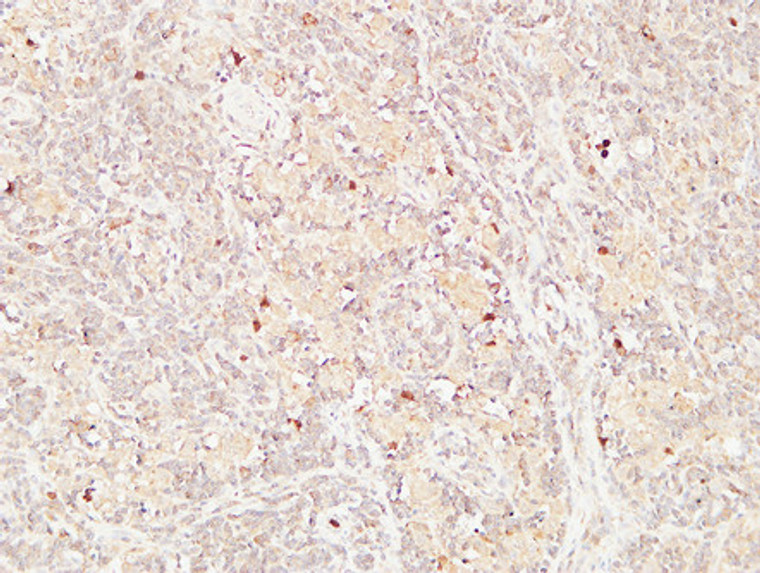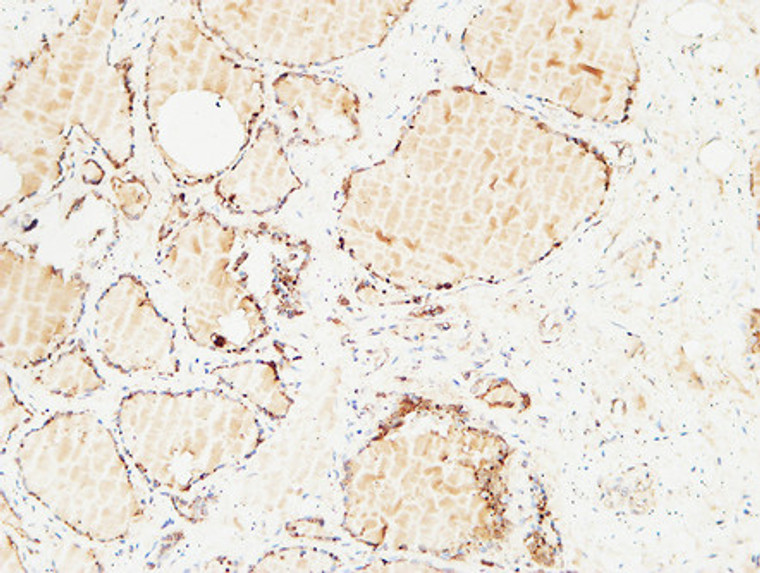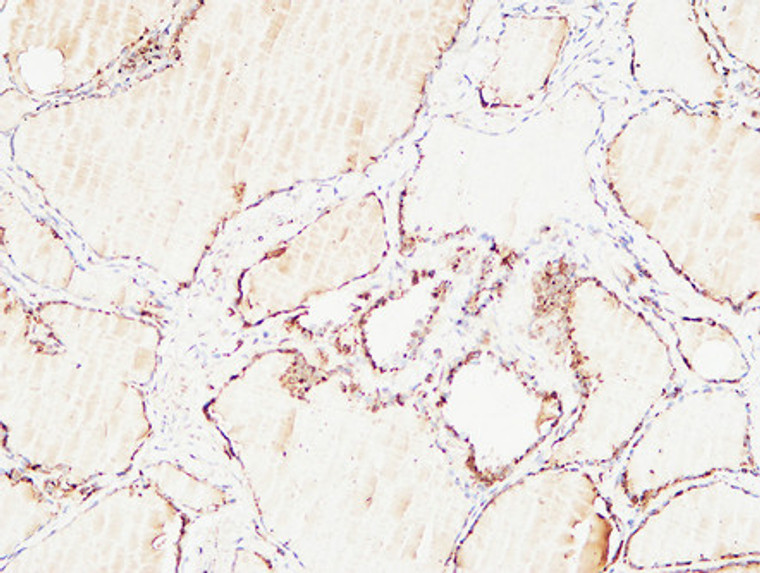| Host: |
Rabbit |
| Applications: |
IHC/IF/ELISA |
| Reactivity: |
Human/Mouse/Rat |
| Note: |
STRICTLY FOR FURTHER SCIENTIFIC RESEARCH USE ONLY (RUO). MUST NOT TO BE USED IN DIAGNOSTIC OR THERAPEUTIC APPLICATIONS. |
| Short Description: |
Rabbit polyclonal antibody anti-Thyroglobulin (2511-2560 aa) is suitable for use in Immunohistochemistry, Immunofluorescence and ELISA research applications. |
| Clonality: |
Polyclonal |
| Conjugation: |
Unconjugated |
| Isotype: |
IgG |
| Formulation: |
Liquid in PBS containing 50% Glycerol, 0.5% BSA and 0.02% Sodium Azide. |
| Purification: |
The antibody was affinity-purified from rabbit antiserum by affinity-chromatography using epitope-specific immunogen. |
| Concentration: |
1 mg/mL |
| Dilution Range: |
IHC-P 1:50-200ELISA 1:10000-20000IF 1:50-200 |
| Storage Instruction: |
Store at-20°C for up to 1 year from the date of receipt, and avoid repeat freeze-thaw cycles. |
| Gene Symbol: |
TG |
| Gene ID: |
7038 |
| Uniprot ID: |
THYG_HUMAN |
| Immunogen Region: |
2511-2560 aa |
| Specificity: |
The antibody detects endogenous Thyroglobulin |
| Immunogen: |
Synthetic peptide from the human protein at the amino acid range 2511-2560 |
| Post Translational Modifications | Iodinated on tyrosine residues by TPO. There are 4 pairs of iodinated tyrosines used for coupling: acceptor Tyr-24 is coupled to donor Tyr-149 or Tyr-234, acceptor Tyr-2573 is coupled to donor Tyr-2540, acceptor Tyr-2766 in monomer 1 is coupled to donor Tyr-2766 in monomer 2 and acceptor Tyr-1310 in monomer 1 is coupled to donor Tyr-108 in monomer 2. Sulfated tyrosines are desulfated during iodination. Undergoes sequential proteolysis by cathepsins to release thyroxine (T4) and triiodothyronine (T3) hormones. In the thyroid follicle lumen, cross-linked TG (storage form) is solubilized by limited proteolysis mediated by cathepsins CTSB and/or CTSL. Partially cleaved TG is further processed by CTSK/cathepsin K and/or CTSL resulting in the release of T4. Following endocytosis, further processing occurs leading to the release of T3 and more T4 hormones. |
| Function | Acts as a substrate for the production of iodinated thyroid hormones thyroxine (T4) and triiodothyronine (T3). The synthesis of T3 and T4 involves iodination of selected tyrosine residues of TG/thyroglobulin followed by their oxidative coupling in the thyroid follicle lumen. Following TG re-internalization and lysosomal-mediated proteolysis, T3 and T4 are released from the polypeptide backbone leading to their secretion into the bloodstream. One dimer produces 7 thyroid hormone molecules. |
| Protein Name | ThyroglobulinTg |
| Cellular Localisation | SecretedSecreted Into The Thyroid Follicle LumenLocalizes To Colloid GlobulesA Structure Formed In The Thyroid Follicle Lumen Consisting Of Cross-Linked Tg Arranged In Concentric Layers |
| Alternative Antibody Names | Anti-Thyroglobulin antibodyAnti-Tg antibodyAnti-TG antibody |
Information sourced from Uniprot.org
12 months for antibodies. 6 months for ELISA Kits. Please see website T&Cs for further guidance












